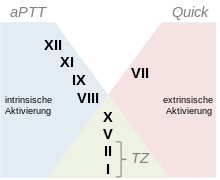Quick value
The Quick value (after the American doctor Armand James Quick ), also known as the one-step prothrombin time , is a laboratory parameter of the functional performance of the extrinsic system of blood coagulation . It can be determined from the measured thromboplastin time ( TPZ ; English prothrombin time , PT ). The International Normalized Ratio (INR) is comparable across laboratories .
Demarcation
This test does not measure the intrinsic (endogenous) system of blood clotting. For example, the blood of people with haemophilia ( blood disease) has a normal Quick value. The partial thromboplastin time (aPTT) provides information about the functional performance of the intrinsic system. The plasma thrombin time (PTZ) indicates the clotting time of the common end section of the extrinsic and intrinsic path.
Use / application
In many patients is drug producing various coagulation factors by oral anticoagulants - for example with coumarins - inhibited in the liver; this increases the INR (therapeutic). Furthermore, an increased INR value can indicate a synthesis disorder of the coagulation factors due to liver damage (liver failure, liver cirrhosis).
Determination of the quick value (quick test)
In order to avoid immediate clotting, a blood sample is mixed with citrate , which binds the calcium required for clotting . This citrated blood is centrifuged in the laboratory and the analysis is carried out from the excess blood plasma .
Calcium is added to the plasma in excess, the sample is heated to 37 ° C and tissue factor (= tissue factor = (tissue) thromboplastin) is added, which activates the exogenous pathway of blood clotting . Then the time to the appearance of fibrin threads is measured . With normal blood clotting, this takes 11 to 16 seconds.
In practice, the test can be carried out as follows: The plasma is placed in a thimble-sized beaker together with a small steel ball. The cup is a little crooked and rotates so that the steel ball rolls through the liquid and is always at the lowest point of the cup. Then thromboplastin and calcium are added and the time is taken. Fibrin threads slowly form, which change the viscosity of the liquid: the steel ball rolls less and less through the liquid, gets stuck in it at some point and then rotates with the cup. A light barrier at the top of the bottom of the cup registers this and stops the time.
interpretation
The thromboplastin time is measured in seconds, but the Quick value is a percentage. Armand James Quick tried to find a relationship between the thromboplastin time and the amount of coagulation factors present (the prothrombin consumed in the course of the coagulation process was the basis for the prothrombin consumption test according to Quick). To create a calibration curve , he took standard plasma ( blood plasma mix from many people with normal coagulation) and measured the thromboplastin time of this standard plasma in various dilutions. The Quick value (in percent) of the blood of the examined corresponds to the dilution of the standard plasma that would have to be produced in order to obtain the same thromboplastin time. The table below illustrates this using a few sample figures:

| Thromboplastin time [s] | Dilution of the standard plasma | Quick value [%] |
|---|---|---|
| 14th | 1: 1 (undiluted) | 100 |
| 21st | 1: 2 | 50 (1/2) |
| 28 | 1: 3 | 33 (1/3) |
| 35 | 1: 4 | 25 (1/4) |
A Quick value of 50 percent means that the plasma of the person examined coagulates as quickly as a "standard plasma" that has been diluted in a ratio of 1: 2 (to 50 percent of the original concentration), like a plasma that only contains 50 percent of the Contains “norm” of coagulation factors. This is not the same as a plasma that coagulates half as fast as "standard plasma". A Quick value of 50 percent does not mean a doubling of the clotting time.
- comparability
There are many providers of coagulation tests worldwide (for example Hepatoquick®, Thromborel® etc.) that work according to the above-mentioned principle. However, these use different tissue thromboplastins , which is reflected in different test results, both in the seconds and in the percentages. The results of the tests sometimes differ greatly from one another. This is why Quick values from different laboratories cannot be compared with one another. To provide better comparability to achieve in the measurement of blood clotting time, was therefore of the World Health Organization - (WHO World Health Organization) of the INR (International Normalized Ratio) developed. Every provider of a Quick coagulation test supplies a conversion formula with which the Quick values can be converted into the INR. However, the Quick value is still used frequently in everyday clinical practice.
Web links
Individual evidence
- ↑ Ludwig Heilmeyer , Herbert Begemann: Blood and blood diseases. In: Ludwig Heilmeyer (ed.): Textbook of internal medicine. Springer-Verlag, Berlin / Göttingen / Heidelberg 1955; 2nd edition ibid. 1961, pp. 376-449, here: pp. 387 f. ( Methods of investigation for the diagnosis of hemorrhagic diatheses ).
- ↑ Ludwig Heilmeyer , Herbert Begemann: Blood and blood diseases. In: Ludwig Heilmeyer (ed.): Textbook of internal medicine. Springer-Verlag, Berlin / Göttingen / Heidelberg 1955; 2nd edition, ibid. 1961, pp. 376-449, here: p. 387.

